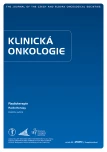Radiobio logical aspects of re-irradiation and their modelling in the determination of the tolerance dose in organs at risk
Authors:
P. Matula; J. Končik; M. Jasenčak; P. Dubinský
Published in:
Klin Onkol 2020; 33(Suppl 1): 31-37
Category:
Review
doi:
https://doi.org/10.14735/amko2020S31
Overview
Background: Re-irradiation, in combination with systemic and biological therapy in recent years, has become a meaningful option for locally recurrent cancers and for in-field second malignancies in cases where surgical salvage is not feasible. The development of imaging techniques and their applications in radiotherapy have created a space for the development of procedures and, by means of radiobiological modelling, for the estimation of the residual/additional tolerance doses for organs at risk (OaR) during re-irradiation. Normal tissues and organs can regenerate and repair their damage after initial radiotherapy. However, residual tolerance doses of OaR are considerably different. In the tissues with early response, a complete restoration occurs almost within a couple of months so that the second series of the exposure could be applied in almost the same amount. In the tissues and organs with the late response, the extent of the damage depends on several parameters: a total dose from the initial therapy, a structure of the sub-functional units of the tissue and an interval between the series. Strong recovery takes place in 3–6 months in case of the skin, mucosa, spinal cord and lung. Other tissue, e. g. kidneys, heart or bladder, dispose with a small regenerative capacity only.
Purpose: The article provides an overview about the cumulative values of the biological effective dose (BEDcum) on organs-at-risk (OaR) obtained from retrospective studies and description of the original model for the determination of the residual tolerance dose implemented to calculating normal tissue complication probability (NTCP) from the individual treatment plans by means of the own-made program „BioGray“.
Keywords:
re-irradiation – cumulative BED – model REG for residual tolerance dose during re-treatment – NTCP – SW BioGray
Sources
1. Dale RG, Jones B. Radiobiological modelling in radiation oncology. [online]. Available from: https: //doi.org/10.1259/9780905749839.
2. Das S, Patro KC, Mukherji A. Recovery and tolerance of the organs at risk during re-radiation. [online]. Available from: http: //www.journalofcurrentoncology.org/article.asp?issn=2589-8892; year=2018; volume=1; issue=1; spage=23; epage=28; aulast=Das
3. Krauze AV, Attia A, Braunstein S et al. Expert consensus on reiradiation for recurrent glioma. Radiat Oncol 2017; 12 (1): 194. doi: 10.1186/s13014-017-0928-3.
4. Matula P. Contribution of simultaneous modelling radiobiological effects in radiation oncology. Habilitation work: Universitis Trnaviensis 2009.
5. Matula P, Končík J. Key to radiobiological modelling effects in radiation oncology. Lambert Academic Publishing 2018.
6. Mayer R, Sminia P. Reirradiation tolerance of the human brain. Int J Radiat Oncol Biol Phys 2008; 70 : 1350–1360. doi: 10.1016/j.ijrobp.2007.08.015.
7. McDonald MW, Lawson J, Garg MK et al. ACR appropriateness criteria retreatment of recurrent head and neck cancer after prior definitive radiation: expert panel on radiation oncology – head and neck cancer. Int J Radiat Oncol Biol Phys 2011; 80 (5): 1292–1298. doi: 10.1016/j.ijrobp.2011.02.014.
8. Kim MS, Kim W, Park IH et al. Radiobiological mechanisms of stereotactic body radiation therapy and stereotactic radiation surgery. Radiat Oncol J 2015; 33 (4): 265–275. doi: 10.3857/roj.2015.33.4.265.
9. Nieder C. Second re-irradiation. A delicate balance between safety and efficacy. Phys Med 2019; 58 : 155–158. doi: 10.1016/j.ejmp.2019.01.004.
10. Oinam SA, Singh L, Shukla A et al. Dose Volume Histogram analysis and comparison of different radiobiological models using in-house developed software. J Med Phys 2011; 36 (4): 220–229. doi: 10.4103/0971-6203.89971.
11. Sminia P, Oldenburger F, Slotman BJ et al. Re-irradiaton of human spinal cord. Strahlenther Onkol 2002; 178 (8): 453–456. doi: 10.1007/s00066-002-0948-1.
12. Stewart FA. Retreatment tolerance of normal tissues. In: Steel G. Basic Clinical Radiobiology. 3rd ed. London: ARNOLD Publishers 2006.
Labels
Paediatric clinical oncology Surgery Clinical oncologyArticle was published in
Clinical Oncology

2020 Issue Suppl 1
- Metamizole vs. Tramadol in Postoperative Analgesia
- Metamizole at a Glance and in Practice – Effective Non-Opioid Analgesic for All Ages
- Metamizole in perioperative treatment in children under 14 years – results of a questionnaire survey from practice
- Safety and Tolerance of Metamizole in Postoperative Analgesia in Children
- Obstacle Called Vasospasm: Which Solution Is Most Effective in Microsurgery and How to Pharmacologically Assist It?
Most read in this issue
- Secondary tumors and radiotherapy
- Nutrition during radiotherapy of cancer patients
- Diet and its effect on prostate cancer, with a focus on plant-based diet
- TSEI in patients with mycosis fungoides – clinical results
